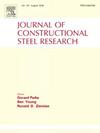Steel plate composite shear walls with 100 MPa concrete and spiral-reinforced boundaries
IF 4
2区 工程技术
Q1 CONSTRUCTION & BUILDING TECHNOLOGY
引用次数: 0
Abstract
This study introduces an innovative spiral-confined concrete-filled steel plate (SCCFSP) composite shear wall that is designed to improve ductility through spiral reinforcement in boundary elements, particularly when high-strength concrete is used. The seismic behavior of SCCFSP composite shear walls was evaluated and compared against two other configurations: (1) walls with tie bars and no boundary elements and (2) walls with stiffeners and concrete-filled steel tube (CFST) columns acting as boundary elements. The test specimens were subjected to a constant compressive axial load and reversed cyclic lateral load. The test results show that the ultimate drift ratio and cumulative energy dissipation of the specimen with stiffeners and CFST columns increased by 55 % and 220 %, respectively, compared to the specimen with tie bars and no boundary elements. The ultimate drift ratio and cumulative energy dissipation of the specimen with spirals in the boundary elements further increased by 61 % and 80 %, respectively, compared to the specimen with stiffeners and CFST columns. A numerical model of SCCFSP composite shear walls was developed to establish the relationship between the ultimate cross-section curvature and spiral details, such as the effective confinement index and spiral configuration length. A design algorithm was also developed to iteratively determine the (a) minimum effective confinement index, (b) minimum spiral length satisfying axial compression ratio, and (c) ultimate drift ratio limitations. Based on numerical simulations of 176 SCCFSP wall sections, simplified formulas are proposed to calculate the minimum effective confinement index and spiral configuration length of spirals within SCCFSP composite shear walls.
100mpa混凝土螺旋配筋边界钢板组合剪力墙
本研究介绍了一种创新的螺旋约束钢板混凝土(SCCFSP)复合剪力墙,该剪力墙旨在通过在边界元素中进行螺旋加固来提高延性,特别是当使用高强度混凝土时。对SCCFSP复合剪力墙的抗震性能进行了评估,并与其他两种结构进行了比较:(1)有拉杆和无边界单元的剪力墙和(2)有加劲筋和钢管混凝土柱作为边界单元的剪力墙。试件承受恒定的轴向压缩载荷和反向循环横向载荷。试验结果表明,加筋和加钢管混凝土柱的试件的极限漂移比和累积耗能比不加边界单元的试件分别提高了55%和220%。与加筋和加钢管混凝土柱的试件相比,加螺旋边界单元的试件的极限漂移比和累积能量耗散分别提高了61%和80%。建立了SCCFSP复合剪力墙的数值模型,建立了极限截面曲率与有效约束指数、螺旋构型长度等螺旋细部的关系。设计算法迭代确定(A)最小有效约束指数,(b)满足轴压比的最小螺旋长度,(c)最终漂移比限制。在对176个SCCFSP复合剪力墙截面进行数值模拟的基础上,提出了计算SCCFSP复合剪力墙内最小有效约束指数和螺旋构型长度的简化公式。
本文章由计算机程序翻译,如有差异,请以英文原文为准。
求助全文
约1分钟内获得全文
求助全文
来源期刊

Journal of Constructional Steel Research
工程技术-工程:土木
CiteScore
7.90
自引率
19.50%
发文量
550
审稿时长
46 days
期刊介绍:
The Journal of Constructional Steel Research provides an international forum for the presentation and discussion of the latest developments in structural steel research and their applications. It is aimed not only at researchers but also at those likely to be most affected by research results, i.e. designers and fabricators. Original papers of a high standard dealing with all aspects of steel research including theoretical and experimental research on elements, assemblages, connection and material properties are considered for publication.
 求助内容:
求助内容: 应助结果提醒方式:
应助结果提醒方式:


